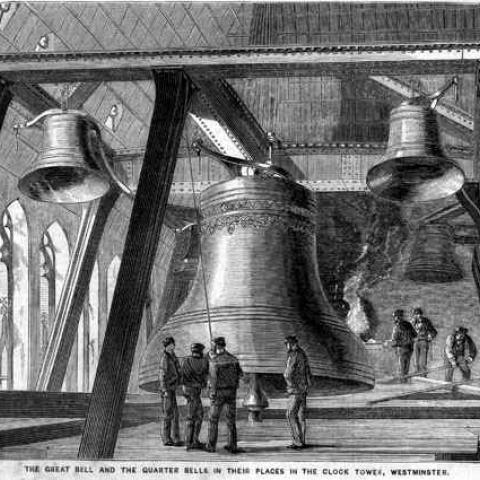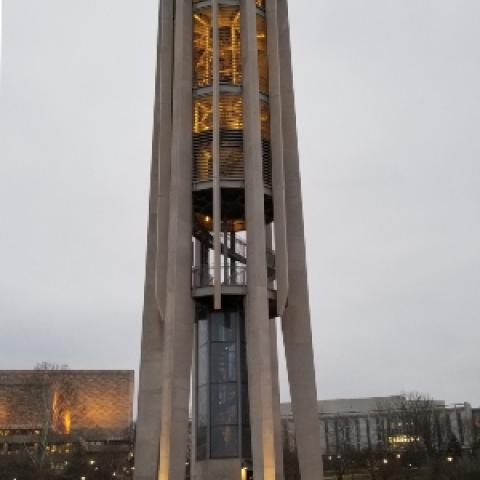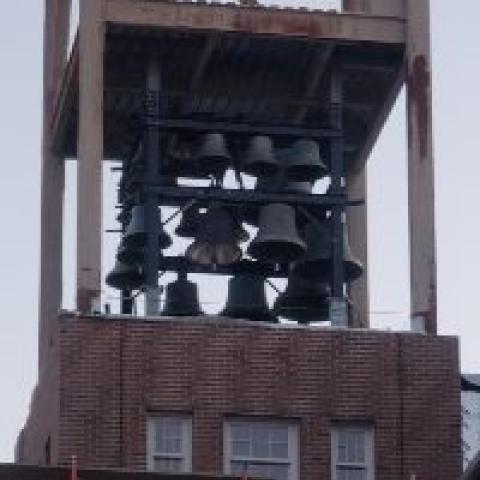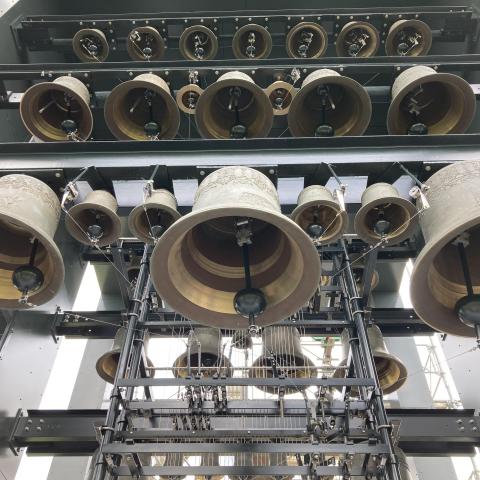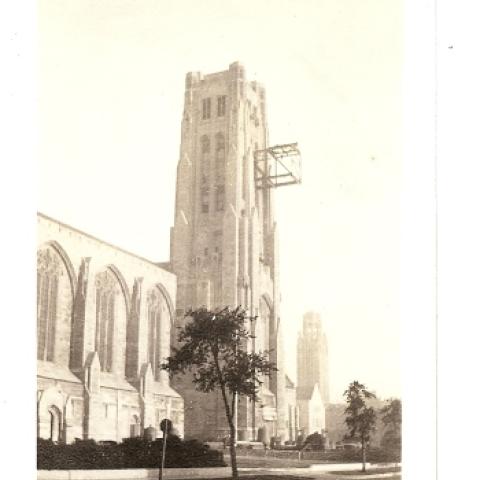Community Bell Advocates, LLC, advises Village of Niles, Illinois, on restoring the bells of the Leaning Tower
Kim Schafer, founder and partner of Community Bell Advocates, LLC, is a bell performer, researcher, and advocate. She has performed on the carillon since a college student in residence at universities across the country and in recital in the United States and Europe. She plays regularly for Sunday services at St. Chrysostom’s Episcopal Church, Chicago. She studied bell instruments as part of her musicological dissertation research, and she now serves as the editor-in-chief of the Bulletin, the journal of the Guild of Carillonneurs in North America. She advises institutions on the repair, installation, performance, and programming of tower bells and bell instruments in North America and coordinates events to promote them.
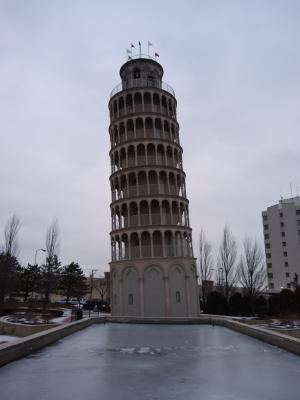
Photo: The Leaning Tower of Niles, Illinois (photo credit: Kimberly Schafer)
The village of Niles, Illinois, on the northwest border of Chicago, has invested in their Leaning Tower, especially in its bells, to renew its status as a central landmark for the village. Originally constructed to conceal water tanks for adjacent pools, this half-size replica of the Leaning Tower of Pisa was built in 1934 as part of Ilgair Park for employees of Robert Ilg’s Hot Air Electric Ventilating Company. The tower and surrounding land were donated by the Ilg family to the YMCA in 1960, and the tower declined in use and purpose as the area transitioned from a recreational park to commercial corridor.
In 1995 the village leased the tower from YMCA, renovating the building and improving the landscaping. Andrew Przybylo, the current mayor of Niles, has bigger plans for the tower and the entire area now that the village has purchased it from the YMCA. He intends to turn the extended site into a vibrant, walkable district for the village with the tower as the renewed icon. Towards this effort, the tower bells at the top of the Leaning Tower of Niles, which have been silent for decades, have been restored to ring out the time and melodies to build and project a sense of community below.
In early 2017, Steven Vinezeano, village manager, contacted Community Bell Advocates (CBA) for their help in researching and restoring the Leaning Tower of Niles bells. The village had five bells at the top of the tower, but they were no longer functioning, nor was their history known. CBA was hired to answer questions about their origins and provenance. Furthermore, CBA was to guide their many options in restoring the bells, including determining which bells could be rung, how they could be remounted, and whether new bells could be added.
By June 2017, CBA had researched and written a full historical report on the five tower bells. Using empirical and archival research and calling on experts in North America and Europe, CBA was able to uncover surprising information. The three largest bells date from the seventeenth and eighteenth centuries. Furthermore, archival research revealed that these three bells, while from disparate sources, were all located in Saint Giles (Egidio) Church of Cavezzo, Italy, before they arrived in Niles. This same church in Cavezzo had desired new bells to replace theirs in the early 1930s. The Barigozzi foundry in Milan, hired to cast the new bells, had taken the old ones in exchange. Rather than melting them down for their bronze to cast the new bells, the foundry likely sold the bells to Robert Ilg or a middleman. The details of this transfer are unknown. The ecclesiastical and city archives of Cavezzo are still in disarray after the 2012 earthquake, which damaged the historic Saint Giles Church as well as many other buildings, and thus these important resources are inaccessible indefinitely.
The other two bells were cast in the nineteenth or twentieth centuries. The fourth bell has no identifiable markings on it save two simple bands at the top. The cast-in clapper staple suggests a casting date prior to 1900, but this mounting technology was so prevalent in the nineteenth century that it could have been cast nearly anywhere in North America or Europe. The fifth bell was cast by the Pacific Brass Foundry of San Francisco in 1912, as noted by the inscription at the very top of the bell. CBA was unable to determine if all five bells were bought as a set or if these two were acquired separately from the three Italian bells. The provenance of these two bells is unknown.
CBA worked with Niles leaders to envision a renewed set of functioning bells that would honor Niles’s historic past and serve its future. The original bells were rung manually via clocking, a method that the village decided to maintain for ceremonial purposes. The village also wanted the bells to be played automatically via computer control, so that they could be heard more frequently. To fill in two empty niches in the tower, create more melodic possibilities, and complement the set of their existing bells, the village decided to order two new bells. Two of the original bells were already known to have cracks, including the largest Italian bell, so the village wanted these repaired. To highlight the Italian provenance of the three bells and the inspiration behind the tower, the village desired to keep the Italian headstock design for the remounted bells
After considering proposals from four different domestic bell firms, B. A.
Sunderlin Bellfoundry in Virginia was chosen for the job in spring 2018. Sunderlin recommended changes to the initial plan that were adopted by the village. The damaged bell four—because of its unknown origins, discordance with the other bells, and difficulty of repair—was put on outdoor display near the Leaning Tower. Unfortunately, the small crack on the largest Italian bell wended through the bell’s interior, making its repair difficult and uncertain. A replica of the bell was cast for functional use, while the original was mounted on display in the tower’s indoor visitor area. All of the bells—of different profiles and founders—were re-tuned to better complement each other. Given the space availability for three new bells instead of only two, the melodic possibilities for the set increased. Sunderlin recommended that the composite set follow a major scale (absent the sixth scale degree), rather than forming a pentatonic scale as originally planned. In effect, Niles found a way to have their cake and eat it too—they were able to maintain the unique soundscape of their bells by keeping three original bells (plus a replica) in their tower, and they were also able to keep two original bells, one of them gorgeously decorated, on display for visitors to view from ground level. Visitors will experience the bells both visually and audibly.
CBA contributed to the project to further distinguish the bells as unique symbols of Niles. CBA arranged many recognizable tunes for use throughout the year, including patriotic tunes, pop tunes, and holiday favorites. In recognition of the village’s prominent Korean population and the desire to make the Leaning Tower of Niles a site of multicultural diversity, CBA arranged a popular Korean folk song, “Arirang,” for automatic play. CBA also composed melodies for their exclusive use, including two clock-chime melodies and a wedding peal for visiting newlyweds. CBA and Sunderlin worked together to design inscriptions and decorations on the three new bells that resembled those on the historic Italian bells, thus revering the history of the original bells while binding together the old and new.
The tower is nearly ready as a public landmark for visitors to explore up close. By January 2020, all seven bells were installed in the tower, and two display bells were installed onsite. Although fully functional, the bells will remain silent until the grand opening ceremony for the tower in spring 2020 (date yet to be determined; for updates, visit: www.vniles.com/883/Leaning-Tower-of-Niles). Other improvements to the tower have been completed: the outside railings have been upgraded to allow visitors to safely climb the tower and lighting is improved to illuminate the tower at night. CBA has provided a programming road map to integrate bell ringing into local events and community life, such as weddings, school science research, and memorial tributes. As a testament to the importance the village places on the tower, the village secured its listing in the National Register of Historic Places in 2019.
The village leaders aspire to transform the area surrounding the Leaning Tower of Niles into a community destination with the tower as the singular centerpiece. The village, CBA, and the Sunderlin Bellfoundry have collaborated to make the bells a critical aural dimension of this vision. Truly, Niles has embraced the historic function of the bell tower representing and projecting community for modern times. CBA was honored to help bring this vision to fruition, making tower bells relevant and dynamic fixtures for the community today.

